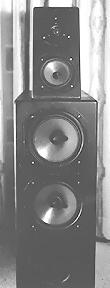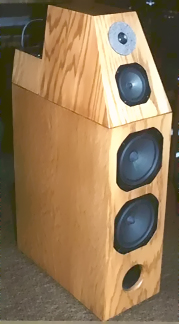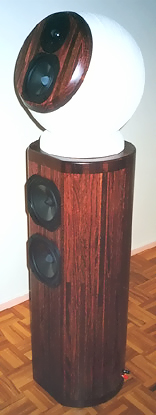Poly Natalia Constructors' Feedback
 The mother...The first Poly Natalia (1993)
The mother...The first Poly Natalia (1993)
The classic Poly Natalia
constructed by Charles Bottemiller
 Stephen Mason's Adaptation
Stephen Mason's Adaptation
of the Poly Natalia (http://hwy.com.au/~stephenm/)
 |
Return-Path: julians@dgabby.mfldclin.edu
Date: Mon, 2 Jun 1997 10:36:02 -0500
From: julians@dgabby.mfldclin.edu (Dr. Scott Julian)
To: blackd@blackdahlia.com
Subject: polynatlia feedback
Dear Dick,
Well, I finally finished the Poly Natalias. Many thanks to you both for the
plan itself and for the help you gave me along the way. This turned out to
be a very successful and enjoyable venture for me. In large part I followed the plan, but I did make a few variations on the way.
CABINETS: My shop is limited, so I had Grenier cabinets in New York build the upper cabs for me. They turned out quite well and the cost was under $200. The bass cabs were built from 1" MDF with double thickness baffles. I used wood glue and screws for assembly. I lined the cabinets with carpet felt and used foam damping. Also, I enlarged the cabinet enough to let me put about 20 pounds of sand in the bottom under a shelf brace. I added a second shelf brace between the drivers. I then built a wood stand and used threaded tiptoes underneath. These are very dead cabinets. I veneered them in red oak and stained a deep red mahogany with multiple coats of gloss lacquer.
The baffles are finished in gloss black furniture lacquer. They are stunning and draw disbelief from everyone who sees them that I actually made them.
DRIVERS AND CROSSOVERS: I used Madisound as my resource for both of these.
They were the cheapest of any source on the drivers, and their service was excellent. Being completely inexperienced with assembly ofelectronics, I also had them build the crossovers to your specs. They used all Solen caps with the exception of the tweeter series cap, which is a Hovland Musicap. The inductors are Goertz alpha core. Assembled cost: $240. They also suggested Nordost flatline for the internal wiring, which I used and am quite happy with. I built some boxes from 3/4" MDF to house the crossovers and finished them in gloss black lacquer as well.
To finish the project I traded off my Classe amp and bought two new Cary CAD 50Mk II monoblocks. These operate in Class A triode mode at 25 watts.
The sound is nothing short of spectacular. These speakers image as well as anything I have ever heard and are virtually invisible. Their transparency and natural midrange are superb. Bass is tight yet full. They are much better than the Alons they replaced (this says a lot, as I think the Alon was a great speaker as well).
Again many thanks. Your kindness will provide me many hours of musical enjoyment.
Regards,
Scott Julian
Chippewa Falls, WI
Date: Sun, 02 Mar 1997 13:27:12 -0500
From: Drew Harty/Linda Norris
Dear Mr. Olsher,
I have e-mailed you several times in the past about your Poly Natalia speakers which, I am happy to say, I have just completed. I would like to thank you again for your work in developing the design and making it available on the Internet. The results of your work has meant that I, and many others I am sure, can afford to own a highly musical enjoyable speaker. Their balanced and consistent response across the audio spectrum is a great accomplishment.
They are true to the music whether I am listening to a cello solo, a funky jazz group, or a full symphony. I feel like I owe you something back, so I thought I would write out some of the variations I incorporated in my homebuilts that might be interesting to you or other builders.
1.) I varied the proportions of my cabinets mostly for aesthetic reasons, while preserving the 2.8 and .43 cu. ft. internal volumes.
My base cabinets are 12.75w x 22.75d x 29h. The mid/tweeter cabinets run the full width and depth of the bass cabinet with the sides angled in eleven degrees and the back angled in the same amount as the front baffle (20 degrees). There is an internal wall in the mid/tweeter cabinet to maintain the correct enclosure volume and the mid and tweeter crossovers are mounted behind the wall where acoustical energy won't affect them and they are accessible.
There is a 2.25" radius bevel cut down each side of the mid/tweeter and bass cabinet baffles. These dimensions are more visually pleasing than the bulky Swan Allures and they look smaller in a room.
2.) All major panels in the bass and mid/tweeter cabinets are a laminate of two sheets of 1/2" MDF with an 1/8" core of a PVC/graphite sheet compound.
All three layers, and an outer cherry veneer, were laminated together with a thickened epoxy resin in a vacum bag--the 4' x 8' vacum bag is a fairly inexpensive item many cabinet builders use. The PVC/graphite compound is used in the boat industry to deaden engine vibrations in sailboat hulls.
It is designed to be laminated with epoxy; it machines well; and it is very effective at deadening resonance in the panels. It is available from Soundown [(800) 359-1036] at $4.00 a sq.ft. which totals about $125 to treate the major panels in the cabinets.
3.) The front baffles of the bass and mid/tweeter cabinets are two 1.25" pieces of MDF laminated with the thickened epoxy. The 2.25" radius was hand planed and sanded (MDF shapes very easily). A sheet of wood veneer was then glued with contact adhesive around the curves and over the front of the baffles. It requires no special equipment to do and gives the baffles a very finished look. I stained my baffles black with leather dye before spraying the entire cabinets with a clear finish.
4.) I used two horizontal shelf brackets and three vertical shelf brackets in the bass cabinet and one horizontal shelf bracket in the mid/tweeter cabinet. The brackets were cut from a quality plywood which is much more torsionally resistant than MDF. I also glued angled blocks where the baffles join the boxes in a butt joint to help stiffen the baffles.
Incidentally, the baffles were stained and sanded before joining them with the boxes which greatly simplified the finishing process.
5.) The bass and mid/tweeter cabinets are separate cabinets bolted together with a layer of microsorb between them. Microsorb is a jelly like sheet material available from Michael Percy Audio that I hope is diminishing the transmission of vibration from the bass cabinet to the mid/tweeter cabinet.
6.) Both the bass and mid/tweeter cabinets have sheets of felt carpet underlayment glued to the internal walls of the cabinets--rear panels have two layers. I was surprised how much this inexpensive addition reduced cabinet vibrations over an untreated wall cabinet. I would guess the combination of different densities from the carpet felt and wool stuffing I used also helps reduce standing waves inside the cabinets.
7.) The crossovers are built just as you specified using Hovland caps in the tweeter x-overs, MIT RTX bypasses on Solen caps in the mid x-overs, and solen caps in the bass x-overs. Air core inductors are used throughout. The crossover boards are mounted with 1" window insulating foam tape and rubber grommets.
I spent just over $1800 for all components and materials. Although I have not listened to my speakers next to the Allures, I have noticed one important differences between the two. Using a very unscientific method--running my finger tips over the cabinets and baffles during playback--I have found my homebuilts vibrate less during loud passages, particularly on the side panels.
Whether the sonic difference I think I remember hearing between my homebuilts and Allures are real or imagined, I could not say conclusively.
I will say I am very pleased with my homebuilts, and my extra efforts seem to have been worth it.
I hope this information may be of some benefit to you or other builders, and thanks again for taking the time to developing the Poly Natalias and your generosity in making the design available on the internet.
Sincerely, Drew Harty
Date: Tue, 15 Oct 1996 14:00:56 -0500
From: Mack Pimsarn
To: blackd@blackdahlia.com
Subject: Polynatalia
Dear sir,
I'm happy to report that driving the Polynatalia with Gordon Rankin 2A3 (Sound Practice/9) using Magnaquest QS025 and Audio Note Copper paper in oil coupling is sound wonderful (Only 8,16 Ohms tab on this OPT).
Again, Thank you for sharing easy to make speaker design.
Mack Pimsarn
Oak Park, IL.
Date: Wed, 15 May 1996 20:48:19 -0400
From: Reddy@aol.com
To: blackd@blackdahlia.com
Subject: Polynatalia
Dick,
Thanks so much for the plans for the speakers. This was my first shot at making them. I worked slowly, made sure the boards were joined solid and even covered them with Zebrawood veneer (also first time veneering). They look great ....but the sound....WOW!
Used Solen with small MIT caps, learned how to solder, hey this is lots of fun. Wired with Tara RSC 500, one set of Price posts on the woofer cabinet,hardwired Mid-Tweeter which connects to this. Sold the VTL 225's and replaced with Cary 300's. I had no expectations, but was amased when this combination was first turned on. The sound was sooo musical, had more realism, true tones and substance than I had ever heard before. Instruments in addition have a sense of direction, can tell on some records when a trumpet is blowing straight on or at an angle to the stage.These speakers are also very smooth and extended, never imagined they would sound this involving. I have listened to this setup for about 10 hrs. Know what else I have never heard before.. until Poly&Cary arrived.. a sense of time in the music...these things get the passing of musical time right(er). A friend at work is also building a pair of the PolyNatalias, it has been a lot of fun and friendship and a nice diversion. We work in a manufacturing chem. lab. If you discover any good upgrades for these beauties, please write. Thanks a million.
Bill Reddy,
Byron Center, Mi.
[Listening Room] [ Main Page][[Poly Natalia] [Tip Of the Month] ['Anyone In Love']
[Link Extravaganza] [Lorin Rowan's Info Page] [ Ordering Info] [Jazz Me Page]
Thank you for visiting our WWW site! Please mail us any comments or questions that you may have.
Last modified: July 30, 2002
Visitors to this page:
All images, text, and sound clips (C)1998-2002 Black Dahlia Music All rights reserved.